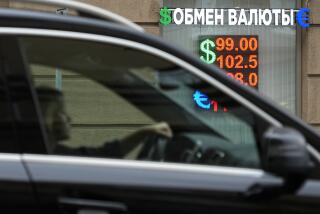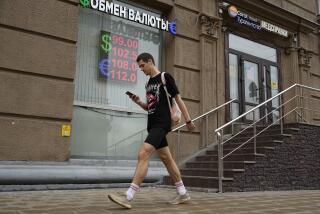In Reversal, Russia to Let Ruble Drift a Third Lower
- Share via
MOSCOW — Caught in a crisis of financial confidence, Russia’s government Monday abruptly jettisoned its long-term policy of maintaining a stable currency at any cost and devalued the ruble by a third.
Announcements on radio and television early in the day informed Russians that their leaders would no longer control the value of the ruble at a level of about 6 to the dollar but would let it slide to a bottom limit of 9.5 to the dollar if the market pushed it downward.
“The measures are tough . . . but unavoidable,” Prime Minister Sergei V. Kiriyenko told reporters. He was backed by other members of President Boris N. Yeltsin’s political elite, including international debt negotiator Anatoly B. Chubais, who said the shock policy change was “adequate and timely.”
Until now, the government has resisted any notion of devaluation. Only Friday, Yeltsin had insisted that there would be no such move--at least not over the weekend.
Devaluing the currency means imports become more expensive--affecting ordinary people’s shopping and making real wages shrink. In a developed economy, a devaluation makes manufactured export goods more competitive; but in Russia, whose main exports are oil, gas and raw materials, it will have little effect.
Whether the sudden change of heart causes panic or restores a measure of normality to Russia’s markets depends on government and Central Bank policy in the next few days, said Maxim Shashenkov, managing director of the investment group Alfa-Kapital.
“It all depends on whether a panicky atmosphere develops in the streets. A lot depends on the policy of the Central Bank and government in the next few days. For the moment, they’re just widening the [ruble] corridor, but if that gets out of hand, as it may well do, then it could become a [full] devaluation.”
Although the United States and the International Monetary Fund had advised Moscow against taking such strong measures so soon, both indicated Monday that they will support the Russians in their latest move.
White House Press Secretary Mike McCurry said that Moscow had made some “difficult” decisions in taking the steps it did. He said the United States will “continue to work with Russia” and the IMF “to support the reform process in the Russian Federation.”
The government and Central Bank said there would be a 90-day moratorium on repayments of some foreign debt. Later, however, officials gave repeated assurances that they will not default on foreign debt.
Monday’s currency move, which politicians denied constituted a formal devaluation, followed weeks of panic triggered by the latest bout of Asian instability and lower prices for oil, Russia’s biggest export. The Moscow stock exchange has lost more than 70% of its value in the last six months.
Ever since a $22.6-billion IMF ruble bailout package announced last month failed to reassure investors, the Russian government, reluctant to abandon the stable-currency policy it had stuck to since 1995, has spent millions propping up the ruble. With large amounts of ruble-denominated debt coming due this year and investors fleeing stock and treasury bill markets, fears have been growing that the government would be forced to devalue and default on its debt.
By Monday, Kiriyenko had apparently rethought the wisdom of an economic policy that pinned everything on ruble stability rather than growth, and had come to the conclusion that his government could not afford to continue protecting the currency at what had come to seem unreasonably high levels.
Markets dropped, then rose on the news, in minuscule trading volumes. The dollar rose against the German mark. IMF delegates, who had rushed to Moscow for emergency negotiations Sunday night, did not comment on the move--which undercuts the basis for their July bailout--but Chubais said that, although “not ecstatic,” they had backed the new Russian direction.
Whether the rest of Russia will be calmed by the nostrums of an elite that ordinary citizens suspect of having systematically cheated them for years is far from clear.
Yeltsin’s many political enemies were swift to predict that the de facto devaluation will bring doom to Russia. Communist leader Gennady A. Zyuganov said it will “hit needy sections of the population, lead to price hikes and simultaneously to crashes of numerous commercial banks.”
“This means only one thing--that the situation in Russia is much worse than might have been supposed a few days ago,” said Gennady N. Seleznyov, chairman of the Duma, or lower house of parliament. The Communist-dominated legislature will meet Friday for what is likely to be a stormy discussion about Russia’s economic situation.
“Although the government is saying that the dollar will not go higher than 7 rubles, I doubt that, since the ceiling has been fixed at 9 rubles,” Seleznyov said, adding that he was “very apprehensive that a serious panic could begin now.”
Officials from Russia’s 12 biggest banks pooled resources to save one another from the possible consequences of the policy. One bank president, Vladimir Vinogradov of Inkombank, said the Central Bank had the resources to keep the currency between 7 and 7.5 rubles to the dollar.
On the street, Russia’s 150 million voters waited with increasing trepidation for the suffering they believed will inevitably follow what many saw as yet another cynical experiment on their lives.
“Nothing bad has happened yet, no price rises. But all these long-winded government explanations about these ivory-tower things that have no direct effect on us just goes to show that our rulers are plotting something,” said 77-year-old Galina Likhtina, a former librarian.
“If there’s one lesson I’ve learned in my life, it’s never to trust the government,” the pensioner added watchfully.
Russian consumers have only recently learned to trust the ruble, after routinely converting their money into dollars throughout the early 1990s during a long and painful period of post-Soviet hyper-inflation. Russian towns and cities have currency exchange offices on every main street.
On Monday, most of these offices had apparently spontaneously closed “for stock-taking.” Many had exchange prices posted of between 7.5 and 9 rubles to the dollar--but had no dollars actually available for exchange.
In an eerily quiet atmosphere for a usually busy working day, Muscovites wandered from exchange office to exchange office, looking for a way to turn their money into safe dollars but finding few outlets at which they could do so. Most suspected the government of some new skulduggery.
“My impression is that, if the ruble is devalued, people will start running around like crazy, like ants in an anthill that has just been disturbed. No one will be able to tell what exactly has happened, but everyone will know that something is wrong,” said 39-year-old Nikolai Golovlev, a graphic designer who lives in central Moscow.
Vasily Grishchenko, a 62-year-old pensioner and army veteran, was wondering whether to buy dollars at a rate of 8.5 rubles and was full of regrets.
“I’ve been keeping all my savings in rubles, because for once I thought the government had maintained a stable exchange rate for long enough for people to trust it,” Grishchenko said. “What a fool I was!”
Only Igor, a 28-year-old “new Russian” with all the attributes of post-Soviet wealth--a mobile phone at his belt and a shiny new Audi parked at the curb--was unconcerned about the fate of his national currency.
“Devaluation! I’m not worried,” he grinned, adding that he is paid in dollars. “I keep my money in a jam jar and sleep like a log every night.
“At the same time, I feel sorry for the millions of poor Russians who are getting shortchanged again.”
Times staff writer Art Pine in Washington contributed to this report.
* DEVALUATION DOMINO: If unsuccessful, Russia’s action could add to the woes of other hard-hit economies. D1
* BLUE CHIPS GAIN: The Dow rose 149, its biggest increase in two months. D1
(BEGIN TEXT OF INFOBOX / INFOGRAPHIC)
Falling Ruble
Russian rubles to U.S. dollar
August 1997: 5.8
August 1998: 9.5 (New bottom limit set by Russian government)
Source: Associated Press
More to Read
Sign up for Essential California
The most important California stories and recommendations in your inbox every morning.
You may occasionally receive promotional content from the Los Angeles Times.













